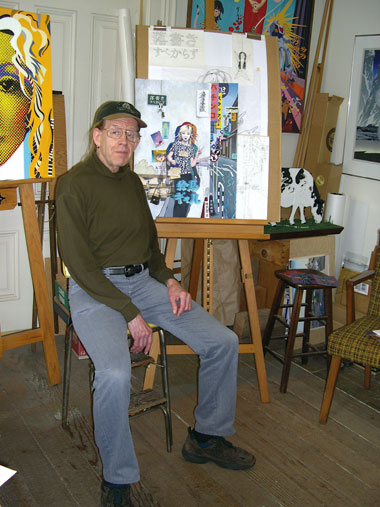A Bridge to Japan: Orr Marshall Retrospective, Morris Graves Museum of Art, 2006-2007
This retrospective exhibition covers a period of 40 years starting with the time when I lived and studied in Japan; so you will see a wide span of styles, from quite realistic to nearly abstract (although there is a representational element in everything here). It is not because I have passed through historical artistic periods (blue period etc.), but because many ideas have occurred to me about ways of seeing and depicting the world.
For instance, what would it look like if I painted everything with dots arranged in a regular grid pattern?
Can I make pictures entirely from straight-edged, square-cornered shapes?
Instead of drawing with outlines, can I draw with juxtaposed black and white patterns?
Can I combine approaches ranging from realism to cartoons and graffiti into the same picture?
Can I make sculpture out of real-looking parts that are recombined in unreal ways?
What if the only way to understand my artwork would be to read the title?
These are some of the conundrums I have posed, with results that you see. Sometimes the work looks almost real, sometimes almost surreal. But each work is conceptually based on something seen in my imagination or in my surroundings which demands to be put into visible shape. A question that pervades this exhibition is:
Can I be Japanese?
Well, certainly not in physical appearance, but mentally? Since my five-year sojourn in Japan, I have stayed in close contact with the culture, and I continue to study the language. I am challenged by the idea of switching mental gears into a different language, by the possibility of operating in a completely new linguistic system with the unique world-view that it entails. I would like to be international and multi-cultural, or at least bicultural. Therefore I have adopted personal versions of imagery from traditional and modern Japanese culture, even writing picture titles, my signature, people's names, signs, comments, noises and so on in various styles of Japanese calligraphy or print. What right do I have to incorporate such things into my own art? Throughout their history, the Japanese have imported aspects of many foreign cultures: from China in the past, more recently from the West and from America in particular. Then they have transformed those elements into something entirely and typically their own. I want to reverse the direction of this current of influence, to look at Japanese culture from my viewpoint as an outsider, and to put various elements of that culture together with my own ideas and see what happens.
